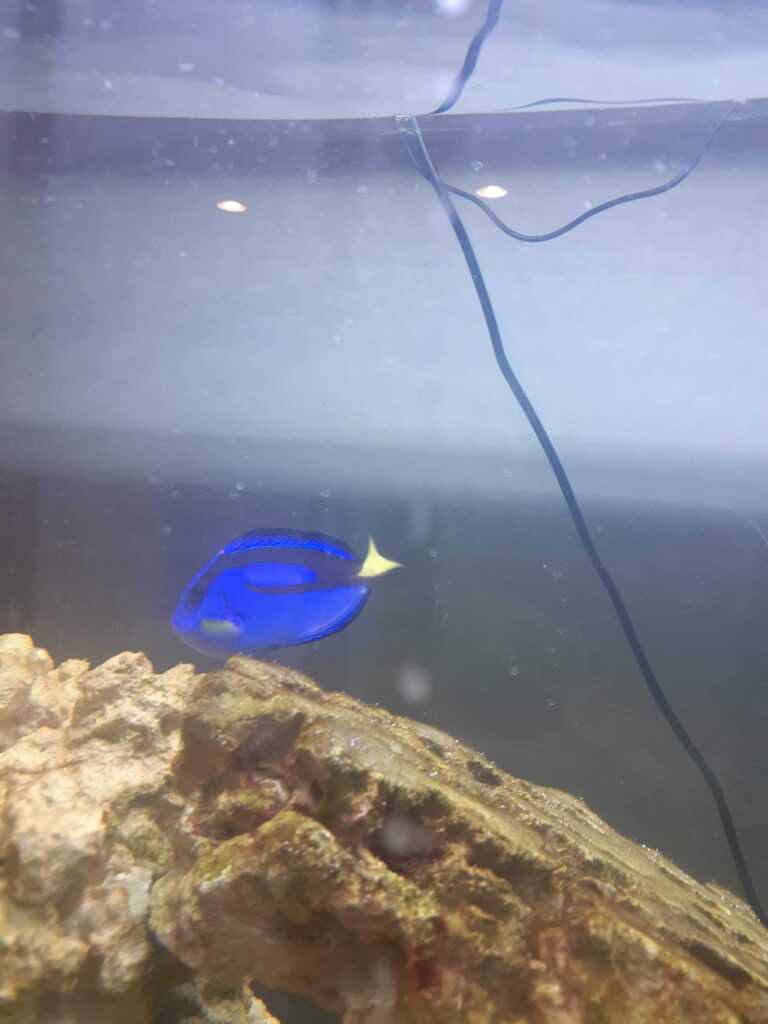Basic Facts About Blue Tangs

| Scientific Family: | Paracanthurus |
| Number of Blue Tang Species Types: | 1. But the Blue Tang is cousins to 86 surgeonfish. |
| Average Life Span: | Blennies can live between 1 and 10 years, depending on the species. An average lifespan in captivity is likely 3 to 5 years. |
| Typical Size: | Size of Blue Tangs will depend on your tank situation. Most are around 3 to 6 in long. Some will be smaller, and some will get up to a foot long. |
| Colors: | Blue Tangs are…blue. But they also have a bright yellow tail and black accents. |
| Native To: | Blue Tangs are found all over he world, but if you get one for your aqaurium, it likely came from he Indo-Pacific region. They are native to Fiji, Indonesia, and the Maldives. |
| Water Conditions Needed: | Temperature: 72-82°F PH Level: 7.8-8.4 Gravity: 1.002 and 1.025 |
| What Do Tangs Eat?: | Blue Tangs eat a lot, and will help you keep your tank clean by eating algae in your tank. Prepared favorites include live and frozen brine shrimp or mysis shrimp. You can also feed them seaweed. |
| Fish-Keeping Experience Level: | Intermediate – Blue Tangs are hardy fish, but do have their quirks. |
| Minimum Tank Size: | Our Ohfishal recommendation is a 50 gallon minimum tank size. Blue Tangs need space to be free! |
| Tank Accessory Requirements: | Heater and Filter. Protein Skimmers are recommended for saltwater tanks. |
| Compatibility – Other Fish: | These are compatible with almost all other saltwater fish other than the ones found below. You will only want to have one Blue Tang in many cases. |
| Compatibility – Plants: | Various types of Hard and Soft Corals. Blue Tangs really like live rock to hide around. |
| Compatibility – Do not Keep Tangs With These Species: | Do not pair Blue Tangs with similar species of Blue Tangs, unless you do it together. Other fish species you should avoid include groupers, lion fish, eels, sharks, rays, and triggerfishes. |
| Can you breed them? | In an aquarium, it is very difficult to breed them. |
| Fun Fact: | Blue Tangs can change their shades, from blue to deep purple! Blue Tangs are also poisonous! |
| Cost: | $70-100+ Blue Tangs, due to their difficult nature to breed, are one of the more expensive saltwater fish. |

How will a Blue Tang behave in your aquarium?
Blue Tangs will bring life to your aquarium. They are active swimmers, and will roam your entire tank. They can disappear in live rock/shelter if you have it, but they won’t be gone long. Tangs will pick at rocks and such for algae, and they typically leave your other fish alone. They are a joy to have!
How to acclimate your Blue Tang to your fish tank?
After you get your Blue Tang, there are a few ways you can introduce your new prized possession to your aquarium. Next, we’ll walk you through one of the easier ways, the Floating Method, but know that there are other ways you can do this as well. Lastly, the main thing we advise is to have the lights turned off, and if you have more aggressive fish, introduce the Blue Tangs when the other fish are sleeping.
Floating Method:
- To begin with, turn off all lights on your aquarium and dim the lights in the room. Remember, if shipped, your Blue Tang has likely been shipped in a dark box, so we don’t want to cause them to freak out by flooding them with lights. Also, if you got him from the store, he/she just rode home in a dark bag, so same rules apply.
- Place the bag with the Blue Tang in it in your aquarium and let it float. Don’t open the bag yet. Let the bag float for about 15 minutes. Doing this will let the temperature of the water in the bag to match the temperature of the water in your aquarium.
- Once you’ve had the bag in the water for 15 minutes, cut a small hole in the bag (if there’s a metal clip, cut the hole right below the metal clip). Open the hole wide enough, and then pour in 1/2 a cup of your aquarium water to the bag. Continue to add 1/2 cup of aquarium water every four minutes until the bag is full.
- Once the bag is full, take the bag and pour out half of the water (not into your aquarium). Repeat step 3 again. This time, when the bag is full, you’ll net your Blue Tang and put it into your fish tank! Make sure to remove the shipping bag from your aquarium, and again, don’t pour the water from the bag into the aquarium but discard of it elsewhere (like your sink).
Most Popular Types of Tangs
- Blue Tang
- Blue Powder Tang
- Yellow Tang
- Purple Tang
- Powder Brown Tang
Which Species Are Best To Pair With Your Tangs?
- Any passive to semi-aggressive Saltwater Fish
Ohfishal Tang Fish Tank Set Up
This is our ultimate checklist for a fish tank with a Blue Tang. Of course, you can do this with less parts or with different parts, this is our all-in ohfishal recommendation. This set-up will run you around $520 (market prices will vary).
- Fish Tank, Filter, Heater, and LED Light – 50 Gallon Fish Tank – $335
- Species – 1 Lawnmower Blenny ($25), 1 Goby ($10), 1 Clownfish ($30), 30 lbs of Dead Rock ($90), 1 bottle bacteria ($25)
If you are starting your aquarium from scratch, please take it slowly. We recommend starting with the Dead Rock first with the Bacteria (for about a week or 2), and then add in your Clownfish. After about 2 weeks, you should be able to add in your Blenny and Goby. Then, after another 2 weeks you could add in the Blue Tang. We’d add the Blue Tang last. Make sure you are frequently testing your water conditions to ensure that ammonia and nitrate levels aren’t spiking. The slower you take it, the less likely you are to lose any fish or other species!
Frequently Asked Questions about Tangs
How big do Blue Tangs get?
Blue Tangs can grow to be more than a foot long, but they typically are 4-6 inches.
Are Blue Tangs poisonous?
Yes, the flesh of a blue tang is poisonous.
Do Blue Tangs eat algae?
Yes, they make great fish for your tank because they will eat algae and help you maintain your system.
